Human Resource Management Issues: Diversity, Conflict, and Leadership
VerifiedAdded on 2020/03/23
|8
|1979
|53
Essay
AI Summary
This paper delves into critical human resource management (HRM) issues, with a primary focus on diversity and conflict. It defines diversity as the integration of various elements of corporate citizenship, emphasizing the importance of human rights within an organization, including labor rights and non-discrimination. The paper discusses the limitations to achieving corporate diversity, particularly biases, which manifest in various forms such as cognitive, conflict of interest, statistical, contextual, and prejudiced biases. These biases can negatively impact productivity and decision-making. The paper also underscores the significance of leadership in fostering a collaborative environment and aligning individual goals with corporate objectives. It emphasizes the role of leaders as role models and their impact on organizational success. The paper references several sources to support its arguments.
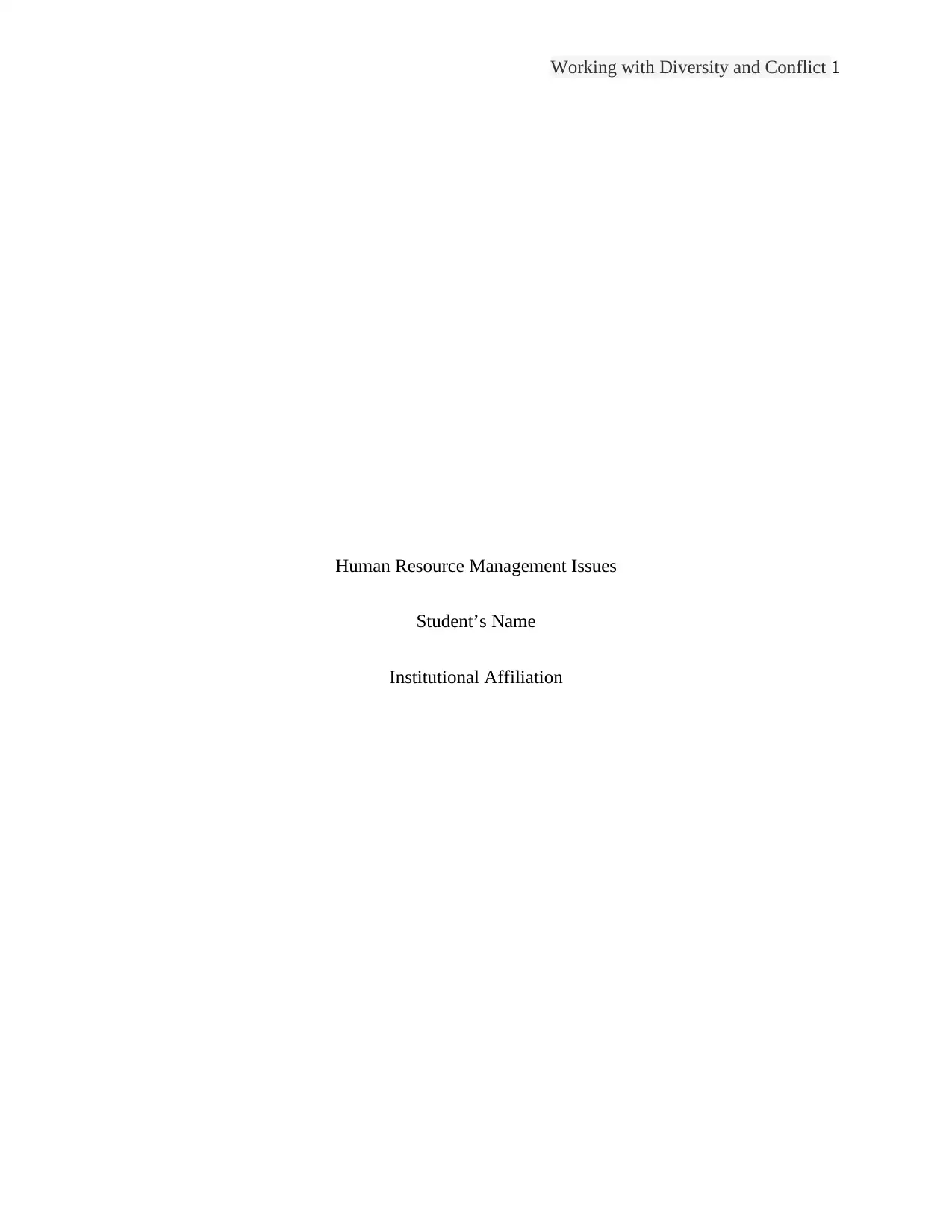
Working with Diversity and Conflict 1
Human Resource Management Issues
Student’s Name
Institutional Affiliation
Human Resource Management Issues
Student’s Name
Institutional Affiliation
Paraphrase This Document
Need a fresh take? Get an instant paraphrase of this document with our AI Paraphraser
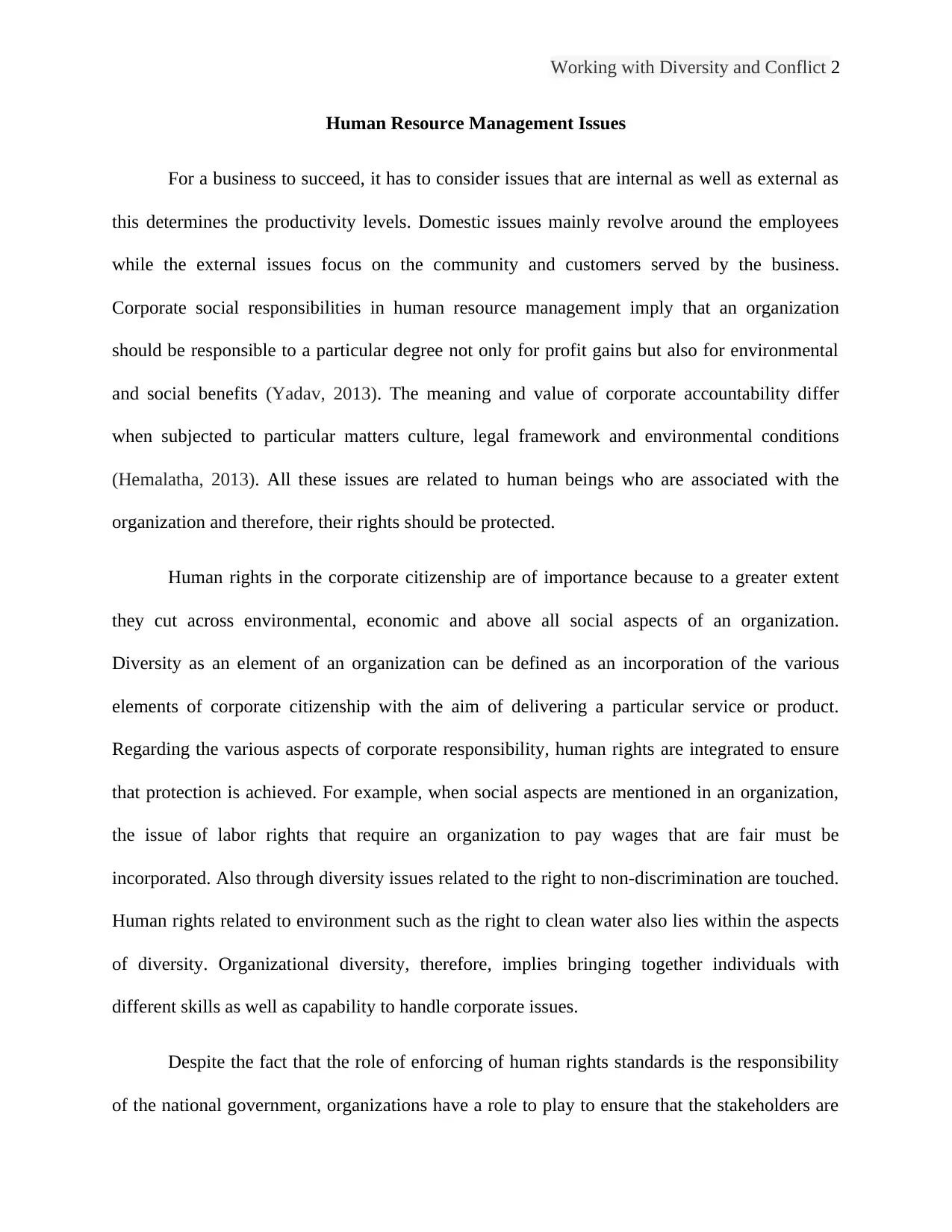
Working with Diversity and Conflict 2
Human Resource Management Issues
For a business to succeed, it has to consider issues that are internal as well as external as
this determines the productivity levels. Domestic issues mainly revolve around the employees
while the external issues focus on the community and customers served by the business.
Corporate social responsibilities in human resource management imply that an organization
should be responsible to a particular degree not only for profit gains but also for environmental
and social benefits (Yadav, 2013). The meaning and value of corporate accountability differ
when subjected to particular matters culture, legal framework and environmental conditions
(Hemalatha, 2013). All these issues are related to human beings who are associated with the
organization and therefore, their rights should be protected.
Human rights in the corporate citizenship are of importance because to a greater extent
they cut across environmental, economic and above all social aspects of an organization.
Diversity as an element of an organization can be defined as an incorporation of the various
elements of corporate citizenship with the aim of delivering a particular service or product.
Regarding the various aspects of corporate responsibility, human rights are integrated to ensure
that protection is achieved. For example, when social aspects are mentioned in an organization,
the issue of labor rights that require an organization to pay wages that are fair must be
incorporated. Also through diversity issues related to the right to non-discrimination are touched.
Human rights related to environment such as the right to clean water also lies within the aspects
of diversity. Organizational diversity, therefore, implies bringing together individuals with
different skills as well as capability to handle corporate issues.
Despite the fact that the role of enforcing of human rights standards is the responsibility
of the national government, organizations have a role to play to ensure that the stakeholders are
Human Resource Management Issues
For a business to succeed, it has to consider issues that are internal as well as external as
this determines the productivity levels. Domestic issues mainly revolve around the employees
while the external issues focus on the community and customers served by the business.
Corporate social responsibilities in human resource management imply that an organization
should be responsible to a particular degree not only for profit gains but also for environmental
and social benefits (Yadav, 2013). The meaning and value of corporate accountability differ
when subjected to particular matters culture, legal framework and environmental conditions
(Hemalatha, 2013). All these issues are related to human beings who are associated with the
organization and therefore, their rights should be protected.
Human rights in the corporate citizenship are of importance because to a greater extent
they cut across environmental, economic and above all social aspects of an organization.
Diversity as an element of an organization can be defined as an incorporation of the various
elements of corporate citizenship with the aim of delivering a particular service or product.
Regarding the various aspects of corporate responsibility, human rights are integrated to ensure
that protection is achieved. For example, when social aspects are mentioned in an organization,
the issue of labor rights that require an organization to pay wages that are fair must be
incorporated. Also through diversity issues related to the right to non-discrimination are touched.
Human rights related to environment such as the right to clean water also lies within the aspects
of diversity. Organizational diversity, therefore, implies bringing together individuals with
different skills as well as capability to handle corporate issues.
Despite the fact that the role of enforcing of human rights standards is the responsibility
of the national government, organizations have a role to play to ensure that the stakeholders are
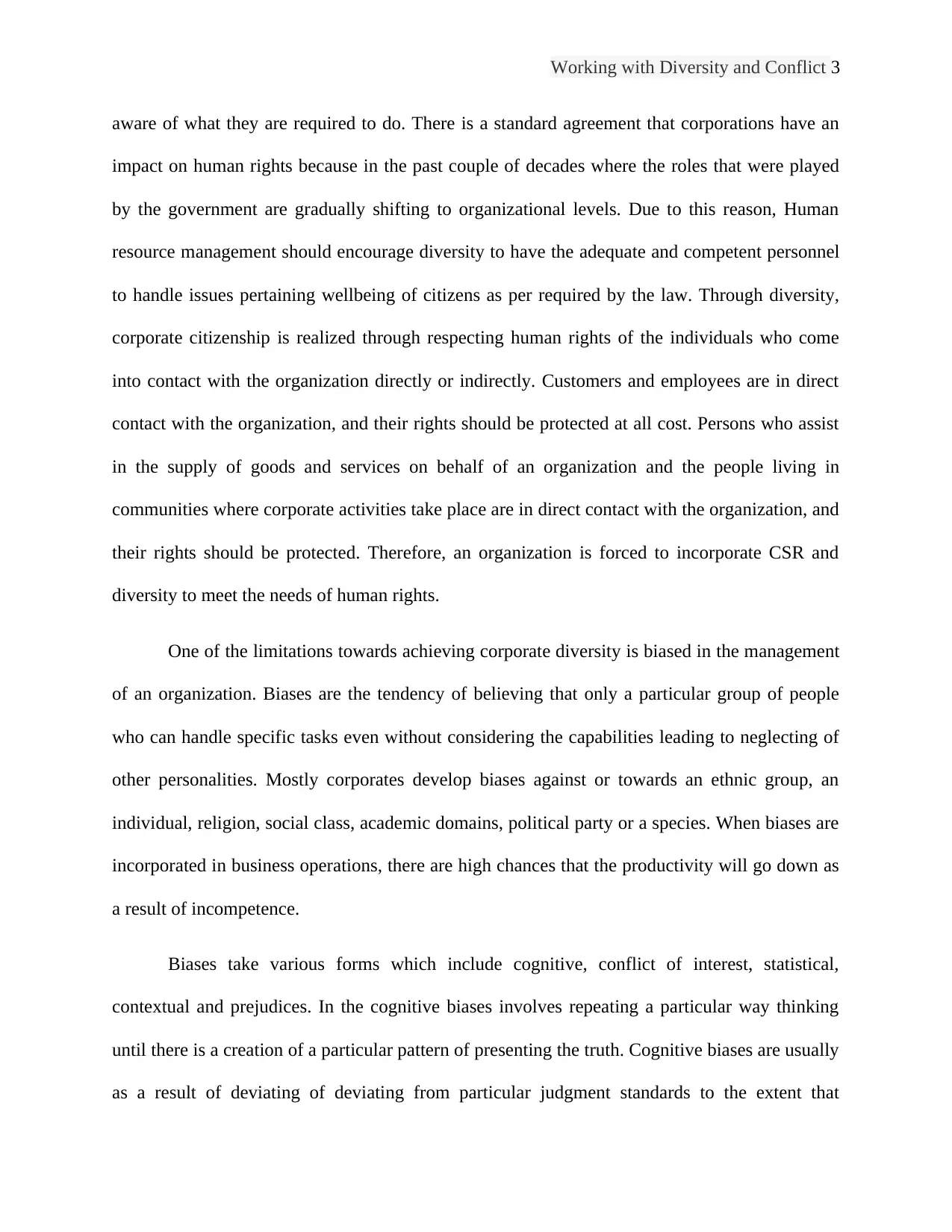
Working with Diversity and Conflict 3
aware of what they are required to do. There is a standard agreement that corporations have an
impact on human rights because in the past couple of decades where the roles that were played
by the government are gradually shifting to organizational levels. Due to this reason, Human
resource management should encourage diversity to have the adequate and competent personnel
to handle issues pertaining wellbeing of citizens as per required by the law. Through diversity,
corporate citizenship is realized through respecting human rights of the individuals who come
into contact with the organization directly or indirectly. Customers and employees are in direct
contact with the organization, and their rights should be protected at all cost. Persons who assist
in the supply of goods and services on behalf of an organization and the people living in
communities where corporate activities take place are in direct contact with the organization, and
their rights should be protected. Therefore, an organization is forced to incorporate CSR and
diversity to meet the needs of human rights.
One of the limitations towards achieving corporate diversity is biased in the management
of an organization. Biases are the tendency of believing that only a particular group of people
who can handle specific tasks even without considering the capabilities leading to neglecting of
other personalities. Mostly corporates develop biases against or towards an ethnic group, an
individual, religion, social class, academic domains, political party or a species. When biases are
incorporated in business operations, there are high chances that the productivity will go down as
a result of incompetence.
Biases take various forms which include cognitive, conflict of interest, statistical,
contextual and prejudices. In the cognitive biases involves repeating a particular way thinking
until there is a creation of a particular pattern of presenting the truth. Cognitive biases are usually
as a result of deviating of deviating from particular judgment standards to the extent that
aware of what they are required to do. There is a standard agreement that corporations have an
impact on human rights because in the past couple of decades where the roles that were played
by the government are gradually shifting to organizational levels. Due to this reason, Human
resource management should encourage diversity to have the adequate and competent personnel
to handle issues pertaining wellbeing of citizens as per required by the law. Through diversity,
corporate citizenship is realized through respecting human rights of the individuals who come
into contact with the organization directly or indirectly. Customers and employees are in direct
contact with the organization, and their rights should be protected at all cost. Persons who assist
in the supply of goods and services on behalf of an organization and the people living in
communities where corporate activities take place are in direct contact with the organization, and
their rights should be protected. Therefore, an organization is forced to incorporate CSR and
diversity to meet the needs of human rights.
One of the limitations towards achieving corporate diversity is biased in the management
of an organization. Biases are the tendency of believing that only a particular group of people
who can handle specific tasks even without considering the capabilities leading to neglecting of
other personalities. Mostly corporates develop biases against or towards an ethnic group, an
individual, religion, social class, academic domains, political party or a species. When biases are
incorporated in business operations, there are high chances that the productivity will go down as
a result of incompetence.
Biases take various forms which include cognitive, conflict of interest, statistical,
contextual and prejudices. In the cognitive biases involves repeating a particular way thinking
until there is a creation of a particular pattern of presenting the truth. Cognitive biases are usually
as a result of deviating of deviating from particular judgment standards to the extent that
⊘ This is a preview!⊘
Do you want full access?
Subscribe today to unlock all pages.

Trusted by 1+ million students worldwide
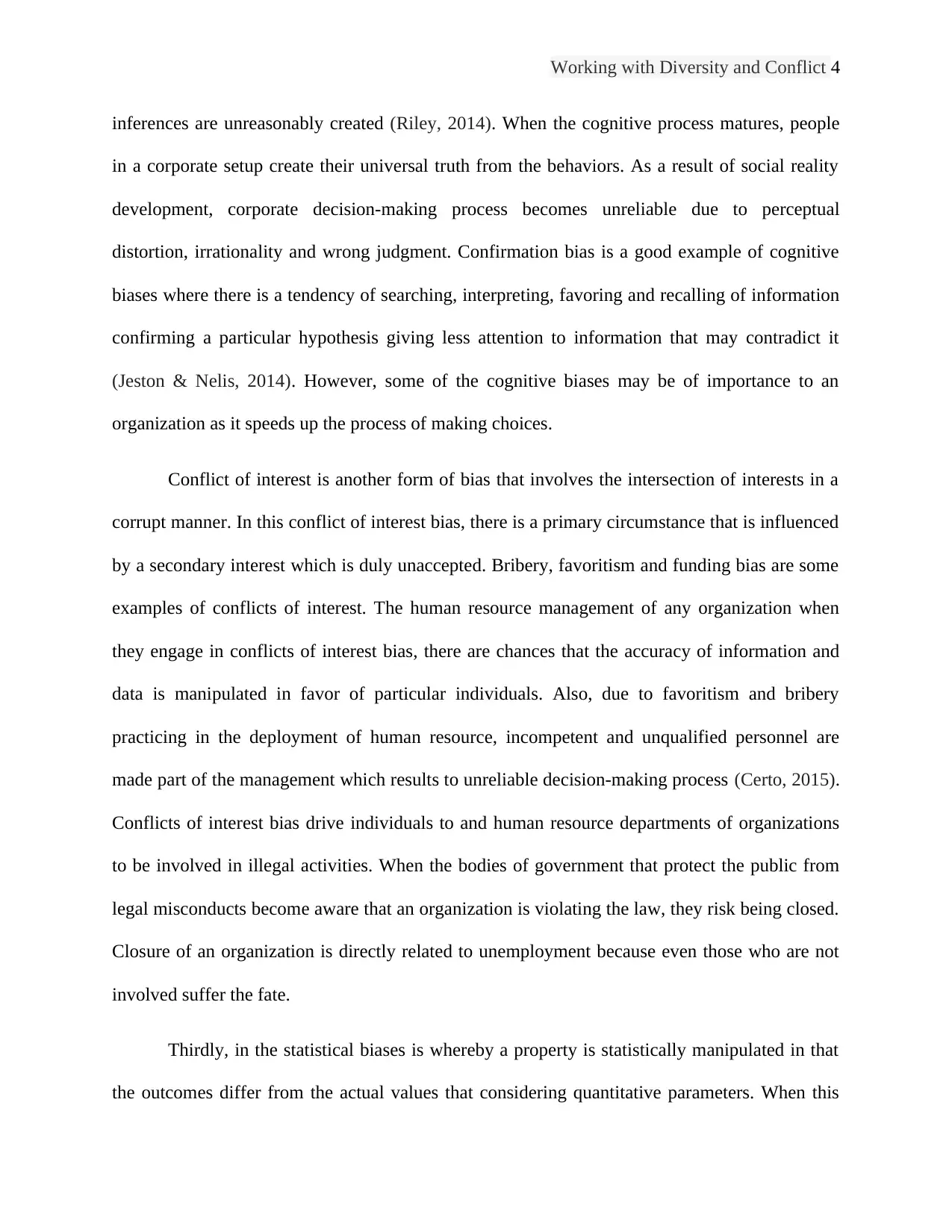
Working with Diversity and Conflict 4
inferences are unreasonably created (Riley, 2014). When the cognitive process matures, people
in a corporate setup create their universal truth from the behaviors. As a result of social reality
development, corporate decision-making process becomes unreliable due to perceptual
distortion, irrationality and wrong judgment. Confirmation bias is a good example of cognitive
biases where there is a tendency of searching, interpreting, favoring and recalling of information
confirming a particular hypothesis giving less attention to information that may contradict it
(Jeston & Nelis, 2014). However, some of the cognitive biases may be of importance to an
organization as it speeds up the process of making choices.
Conflict of interest is another form of bias that involves the intersection of interests in a
corrupt manner. In this conflict of interest bias, there is a primary circumstance that is influenced
by a secondary interest which is duly unaccepted. Bribery, favoritism and funding bias are some
examples of conflicts of interest. The human resource management of any organization when
they engage in conflicts of interest bias, there are chances that the accuracy of information and
data is manipulated in favor of particular individuals. Also, due to favoritism and bribery
practicing in the deployment of human resource, incompetent and unqualified personnel are
made part of the management which results to unreliable decision-making process (Certo, 2015).
Conflicts of interest bias drive individuals to and human resource departments of organizations
to be involved in illegal activities. When the bodies of government that protect the public from
legal misconducts become aware that an organization is violating the law, they risk being closed.
Closure of an organization is directly related to unemployment because even those who are not
involved suffer the fate.
Thirdly, in the statistical biases is whereby a property is statistically manipulated in that
the outcomes differ from the actual values that considering quantitative parameters. When this
inferences are unreasonably created (Riley, 2014). When the cognitive process matures, people
in a corporate setup create their universal truth from the behaviors. As a result of social reality
development, corporate decision-making process becomes unreliable due to perceptual
distortion, irrationality and wrong judgment. Confirmation bias is a good example of cognitive
biases where there is a tendency of searching, interpreting, favoring and recalling of information
confirming a particular hypothesis giving less attention to information that may contradict it
(Jeston & Nelis, 2014). However, some of the cognitive biases may be of importance to an
organization as it speeds up the process of making choices.
Conflict of interest is another form of bias that involves the intersection of interests in a
corrupt manner. In this conflict of interest bias, there is a primary circumstance that is influenced
by a secondary interest which is duly unaccepted. Bribery, favoritism and funding bias are some
examples of conflicts of interest. The human resource management of any organization when
they engage in conflicts of interest bias, there are chances that the accuracy of information and
data is manipulated in favor of particular individuals. Also, due to favoritism and bribery
practicing in the deployment of human resource, incompetent and unqualified personnel are
made part of the management which results to unreliable decision-making process (Certo, 2015).
Conflicts of interest bias drive individuals to and human resource departments of organizations
to be involved in illegal activities. When the bodies of government that protect the public from
legal misconducts become aware that an organization is violating the law, they risk being closed.
Closure of an organization is directly related to unemployment because even those who are not
involved suffer the fate.
Thirdly, in the statistical biases is whereby a property is statistically manipulated in that
the outcomes differ from the actual values that considering quantitative parameters. When this
Paraphrase This Document
Need a fresh take? Get an instant paraphrase of this document with our AI Paraphraser
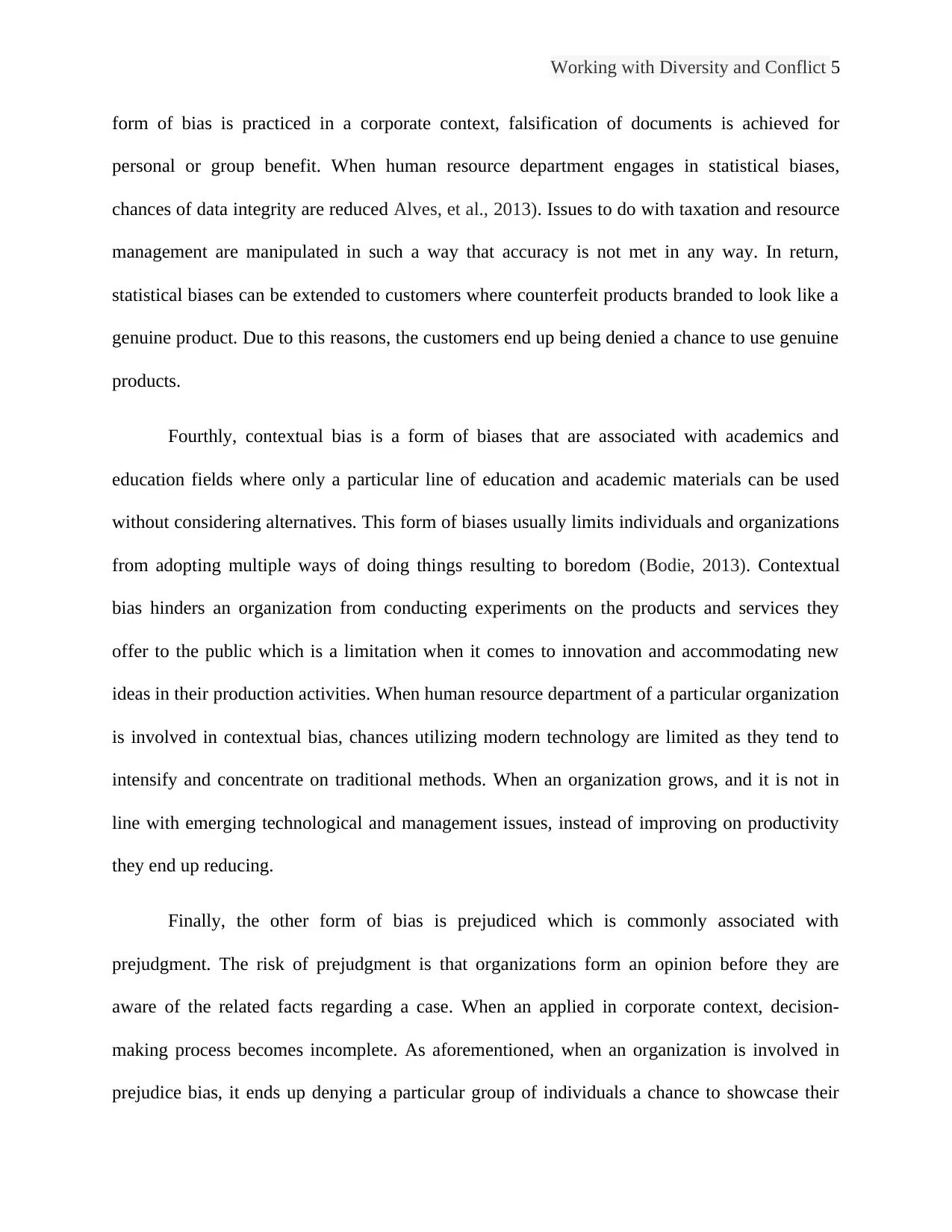
Working with Diversity and Conflict 5
form of bias is practiced in a corporate context, falsification of documents is achieved for
personal or group benefit. When human resource department engages in statistical biases,
chances of data integrity are reduced Alves, et al., 2013). Issues to do with taxation and resource
management are manipulated in such a way that accuracy is not met in any way. In return,
statistical biases can be extended to customers where counterfeit products branded to look like a
genuine product. Due to this reasons, the customers end up being denied a chance to use genuine
products.
Fourthly, contextual bias is a form of biases that are associated with academics and
education fields where only a particular line of education and academic materials can be used
without considering alternatives. This form of biases usually limits individuals and organizations
from adopting multiple ways of doing things resulting to boredom (Bodie, 2013). Contextual
bias hinders an organization from conducting experiments on the products and services they
offer to the public which is a limitation when it comes to innovation and accommodating new
ideas in their production activities. When human resource department of a particular organization
is involved in contextual bias, chances utilizing modern technology are limited as they tend to
intensify and concentrate on traditional methods. When an organization grows, and it is not in
line with emerging technological and management issues, instead of improving on productivity
they end up reducing.
Finally, the other form of bias is prejudiced which is commonly associated with
prejudgment. The risk of prejudgment is that organizations form an opinion before they are
aware of the related facts regarding a case. When an applied in corporate context, decision-
making process becomes incomplete. As aforementioned, when an organization is involved in
prejudice bias, it ends up denying a particular group of individuals a chance to showcase their
form of bias is practiced in a corporate context, falsification of documents is achieved for
personal or group benefit. When human resource department engages in statistical biases,
chances of data integrity are reduced Alves, et al., 2013). Issues to do with taxation and resource
management are manipulated in such a way that accuracy is not met in any way. In return,
statistical biases can be extended to customers where counterfeit products branded to look like a
genuine product. Due to this reasons, the customers end up being denied a chance to use genuine
products.
Fourthly, contextual bias is a form of biases that are associated with academics and
education fields where only a particular line of education and academic materials can be used
without considering alternatives. This form of biases usually limits individuals and organizations
from adopting multiple ways of doing things resulting to boredom (Bodie, 2013). Contextual
bias hinders an organization from conducting experiments on the products and services they
offer to the public which is a limitation when it comes to innovation and accommodating new
ideas in their production activities. When human resource department of a particular organization
is involved in contextual bias, chances utilizing modern technology are limited as they tend to
intensify and concentrate on traditional methods. When an organization grows, and it is not in
line with emerging technological and management issues, instead of improving on productivity
they end up reducing.
Finally, the other form of bias is prejudiced which is commonly associated with
prejudgment. The risk of prejudgment is that organizations form an opinion before they are
aware of the related facts regarding a case. When an applied in corporate context, decision-
making process becomes incomplete. As aforementioned, when an organization is involved in
prejudice bias, it ends up denying a particular group of individuals a chance to showcase their
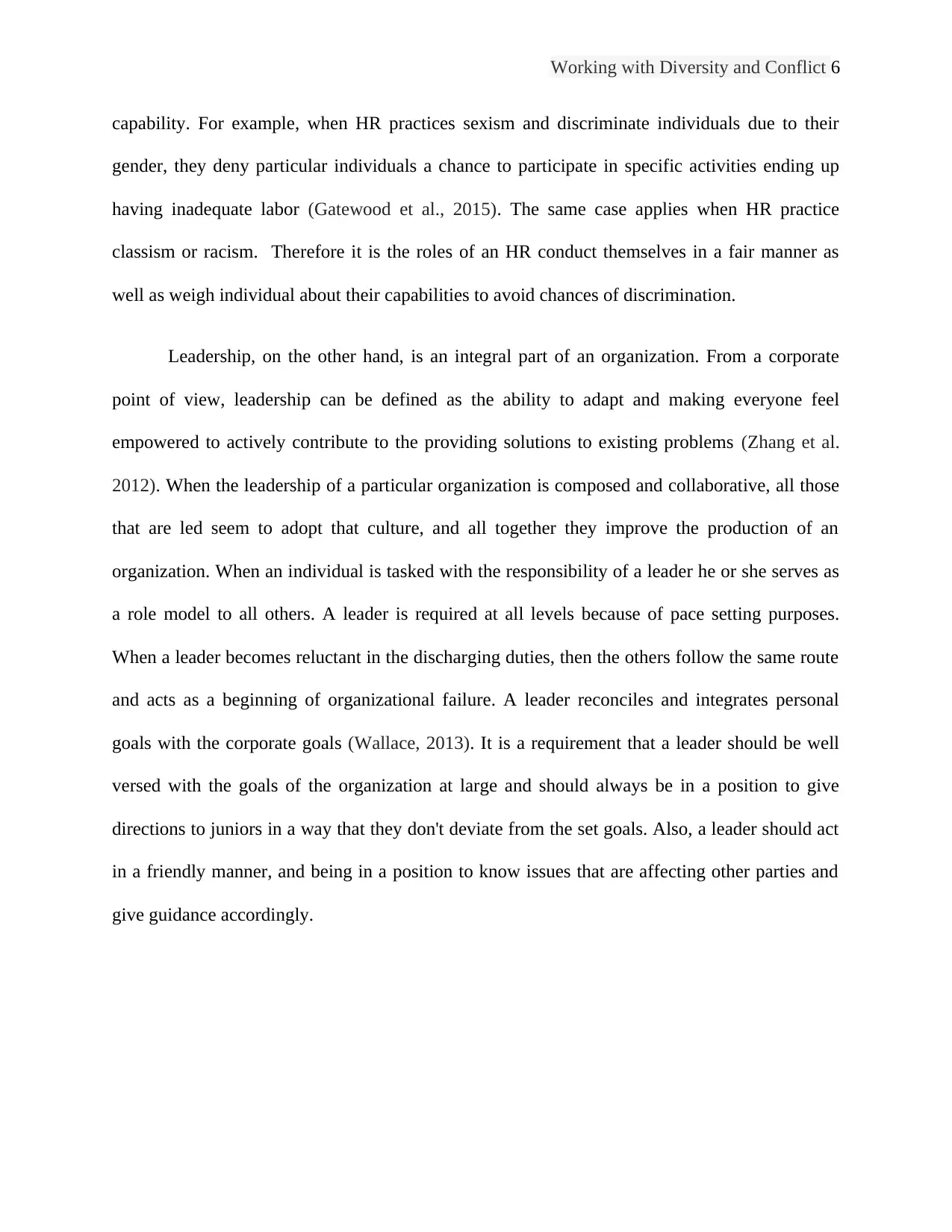
Working with Diversity and Conflict 6
capability. For example, when HR practices sexism and discriminate individuals due to their
gender, they deny particular individuals a chance to participate in specific activities ending up
having inadequate labor (Gatewood et al., 2015). The same case applies when HR practice
classism or racism. Therefore it is the roles of an HR conduct themselves in a fair manner as
well as weigh individual about their capabilities to avoid chances of discrimination.
Leadership, on the other hand, is an integral part of an organization. From a corporate
point of view, leadership can be defined as the ability to adapt and making everyone feel
empowered to actively contribute to the providing solutions to existing problems (Zhang et al.
2012). When the leadership of a particular organization is composed and collaborative, all those
that are led seem to adopt that culture, and all together they improve the production of an
organization. When an individual is tasked with the responsibility of a leader he or she serves as
a role model to all others. A leader is required at all levels because of pace setting purposes.
When a leader becomes reluctant in the discharging duties, then the others follow the same route
and acts as a beginning of organizational failure. A leader reconciles and integrates personal
goals with the corporate goals (Wallace, 2013). It is a requirement that a leader should be well
versed with the goals of the organization at large and should always be in a position to give
directions to juniors in a way that they don't deviate from the set goals. Also, a leader should act
in a friendly manner, and being in a position to know issues that are affecting other parties and
give guidance accordingly.
capability. For example, when HR practices sexism and discriminate individuals due to their
gender, they deny particular individuals a chance to participate in specific activities ending up
having inadequate labor (Gatewood et al., 2015). The same case applies when HR practice
classism or racism. Therefore it is the roles of an HR conduct themselves in a fair manner as
well as weigh individual about their capabilities to avoid chances of discrimination.
Leadership, on the other hand, is an integral part of an organization. From a corporate
point of view, leadership can be defined as the ability to adapt and making everyone feel
empowered to actively contribute to the providing solutions to existing problems (Zhang et al.
2012). When the leadership of a particular organization is composed and collaborative, all those
that are led seem to adopt that culture, and all together they improve the production of an
organization. When an individual is tasked with the responsibility of a leader he or she serves as
a role model to all others. A leader is required at all levels because of pace setting purposes.
When a leader becomes reluctant in the discharging duties, then the others follow the same route
and acts as a beginning of organizational failure. A leader reconciles and integrates personal
goals with the corporate goals (Wallace, 2013). It is a requirement that a leader should be well
versed with the goals of the organization at large and should always be in a position to give
directions to juniors in a way that they don't deviate from the set goals. Also, a leader should act
in a friendly manner, and being in a position to know issues that are affecting other parties and
give guidance accordingly.
⊘ This is a preview!⊘
Do you want full access?
Subscribe today to unlock all pages.

Trusted by 1+ million students worldwide
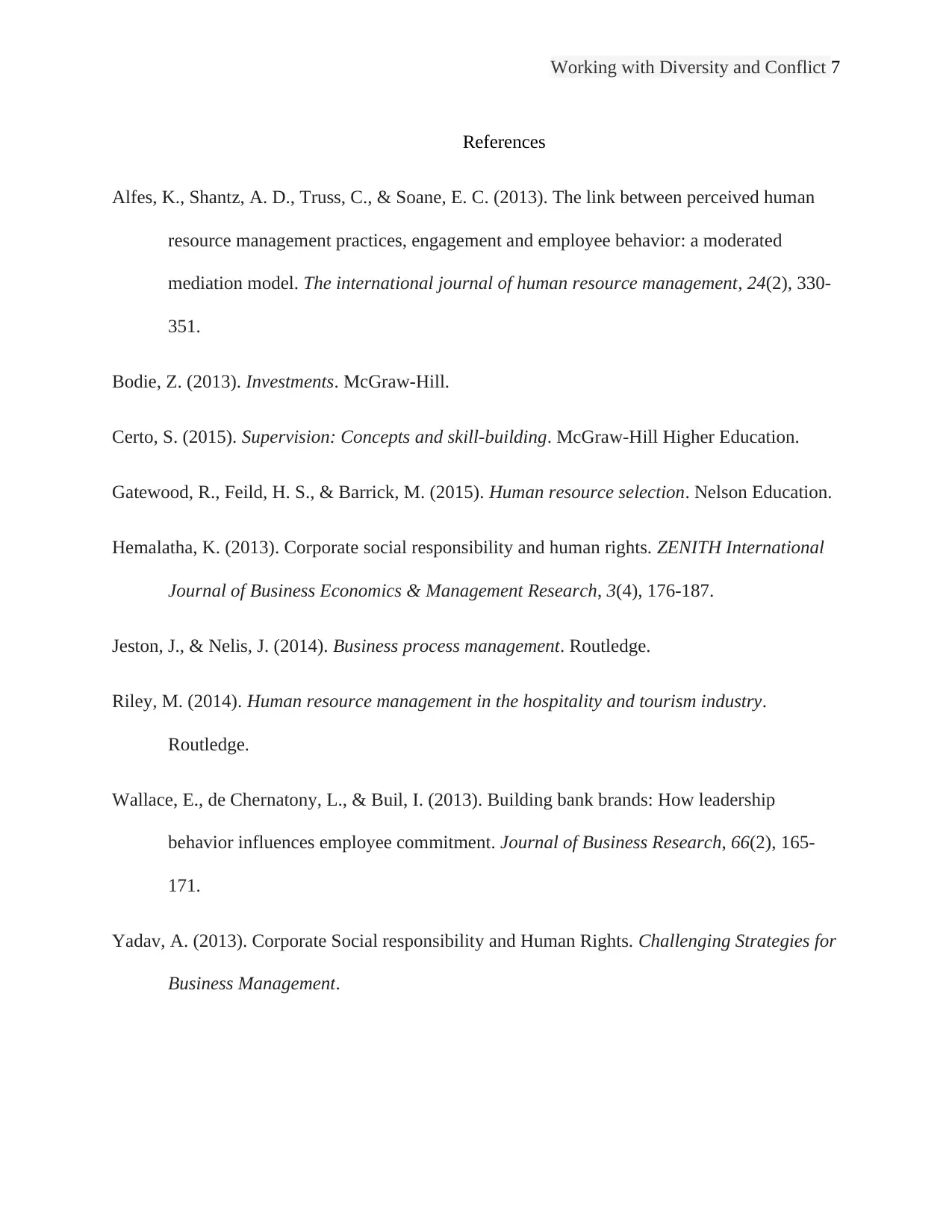
Working with Diversity and Conflict 7
References
Alfes, K., Shantz, A. D., Truss, C., & Soane, E. C. (2013). The link between perceived human
resource management practices, engagement and employee behavior: a moderated
mediation model. The international journal of human resource management, 24(2), 330-
351.
Bodie, Z. (2013). Investments. McGraw-Hill.
Certo, S. (2015). Supervision: Concepts and skill-building. McGraw-Hill Higher Education.
Gatewood, R., Feild, H. S., & Barrick, M. (2015). Human resource selection. Nelson Education.
Hemalatha, K. (2013). Corporate social responsibility and human rights. ZENITH International
Journal of Business Economics & Management Research, 3(4), 176-187.
Jeston, J., & Nelis, J. (2014). Business process management. Routledge.
Riley, M. (2014). Human resource management in the hospitality and tourism industry.
Routledge.
Wallace, E., de Chernatony, L., & Buil, I. (2013). Building bank brands: How leadership
behavior influences employee commitment. Journal of Business Research, 66(2), 165-
171.
Yadav, A. (2013). Corporate Social responsibility and Human Rights. Challenging Strategies for
Business Management.
References
Alfes, K., Shantz, A. D., Truss, C., & Soane, E. C. (2013). The link between perceived human
resource management practices, engagement and employee behavior: a moderated
mediation model. The international journal of human resource management, 24(2), 330-
351.
Bodie, Z. (2013). Investments. McGraw-Hill.
Certo, S. (2015). Supervision: Concepts and skill-building. McGraw-Hill Higher Education.
Gatewood, R., Feild, H. S., & Barrick, M. (2015). Human resource selection. Nelson Education.
Hemalatha, K. (2013). Corporate social responsibility and human rights. ZENITH International
Journal of Business Economics & Management Research, 3(4), 176-187.
Jeston, J., & Nelis, J. (2014). Business process management. Routledge.
Riley, M. (2014). Human resource management in the hospitality and tourism industry.
Routledge.
Wallace, E., de Chernatony, L., & Buil, I. (2013). Building bank brands: How leadership
behavior influences employee commitment. Journal of Business Research, 66(2), 165-
171.
Yadav, A. (2013). Corporate Social responsibility and Human Rights. Challenging Strategies for
Business Management.
Paraphrase This Document
Need a fresh take? Get an instant paraphrase of this document with our AI Paraphraser
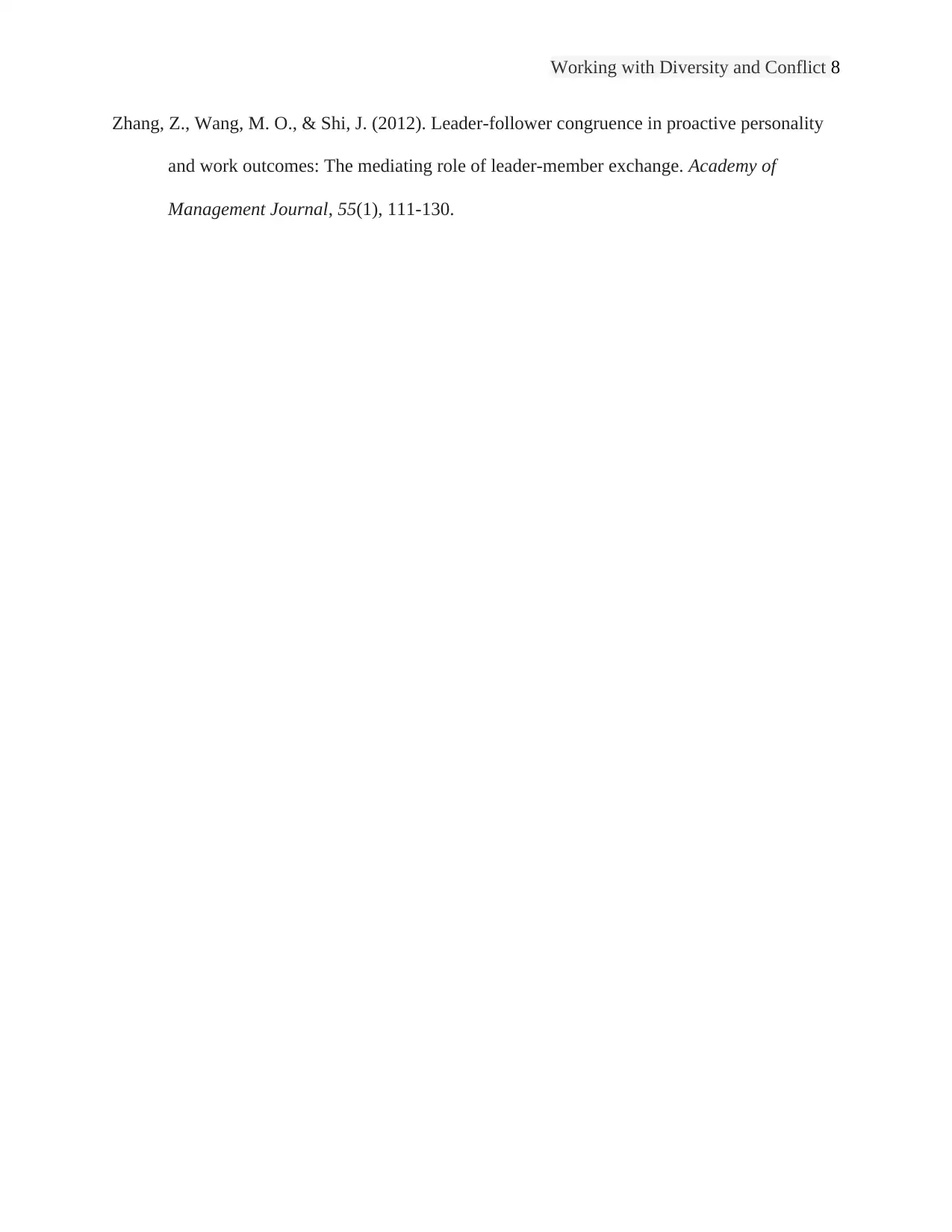
Working with Diversity and Conflict 8
Zhang, Z., Wang, M. O., & Shi, J. (2012). Leader-follower congruence in proactive personality
and work outcomes: The mediating role of leader-member exchange. Academy of
Management Journal, 55(1), 111-130.
Zhang, Z., Wang, M. O., & Shi, J. (2012). Leader-follower congruence in proactive personality
and work outcomes: The mediating role of leader-member exchange. Academy of
Management Journal, 55(1), 111-130.
1 out of 8
Related Documents
Your All-in-One AI-Powered Toolkit for Academic Success.
+13062052269
info@desklib.com
Available 24*7 on WhatsApp / Email
![[object Object]](/_next/static/media/star-bottom.7253800d.svg)
Unlock your academic potential
Copyright © 2020–2025 A2Z Services. All Rights Reserved. Developed and managed by ZUCOL.





